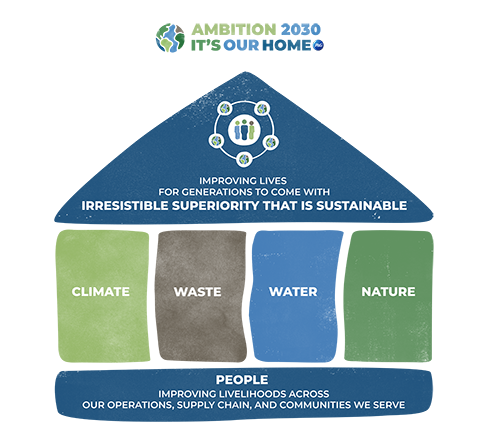Environmental Sustainability.
At JN, environmental sustainability is integral to our business practices. We aim to enhance people’s daily lives in meaningful ways. While our commitment to improvement remains steadfast, the expectations we must meet have evolved. Increasingly, our consumers demand that benefits to them also benefit the planet. We fully embrace this belief. For us, innovation must be both exceptionally effective and sustainable. By collaborating with partners, we can create a better future for everyone. After all, this planet is our shared home, and the time to act is now.
Ambition 2030.
JN Vision 2030 aims to empower our brands to deliver exceptional and sustainable solutions that enhance lives today and for future generations. Central to this vision is the commitment to improving the well-being of people throughout our operations, supply chain, and the communities we support. Our strategy is anchored by four key science-driven pillars—Climate, Waste, Water, and Nature—where we can create the most significant positive impact for both the planet and our business.

AREAS OF IMPACT



We are delivering impact at three levels: reducing our own impact, enabling people to reduce their impact, and scaling industry-wide solutions to reduce environmental impact.

Climate.
Discover more about JN’s initiatives to achieve net zero emissions by 2040.
JN’s goal is to achieve net zero greenhouse gas (GHG) emissions throughout our supply chain and operations – from raw materials to retailers – by 2040. Our climate journey started over a decade ago with targets for our manufacturing facilities. Since then, we have broadened and expedited our initiatives to tackle GHG emissions across the entire life cycle of our products, as well as within our operations and supply chain.
Our focus is on significantly reducing absolute GHG emissions across our entire operations and supply chain to achieve our net zero goal. We will offset any remaining emissions from our operations and supply chain by developing natural or technical solutions that remove an equivalent amount of GHG emissions from the atmosphere. To ensure steady progress towards our 2040 target, we have set near-term science-based objectives for 2030.


Contact Us
If you have any questions, concerns, or need assistance, our customer service team is here to help. For detailed information on how to reach us, please visit our Contact Us page.
NOTICE: We may sell your sensitive personal data.
©2024. JN Corporate. All Rights Reserved.
Do Not Sell or Share My Personal Information / Opt-Out of Targeted Advertising
Do Not Sell/Share/Target
Manage Consent Preferences
Cookie PI/Tracking Technologies
Use this toggle to exercise your right to opt-out of the transfer of your cookie PI by tracking technologies to third parties that would be considered a “sale” or “share” and/or processing cookie PI for purposes of targeted advertising.
When set to “Yes”, you will remain opted-in which allows for the “selling” and “sharing” of your cookie PI and for using your cookie PI for targeted advertising. When set to “No”, you will be opted out of those processing activities on our websites. You can change your selection at any time by moving the toggle and clicking “Confirm My Choices.”
Non-Cookie PI
As a consumer, you may have engaged with us in ways other than just visiting our websites or using our mobile applications. For example, you may have registered for one of our brand programs on a website or within a mobile application. To make a request to opt-out of the “sale”, “sharing” of non-cookie PI or use of your non-cookie PI for targeted advertising, please complete the required fields in this webform.
For further details on how P&G processes your personal data, please see our Privacy Policy.
